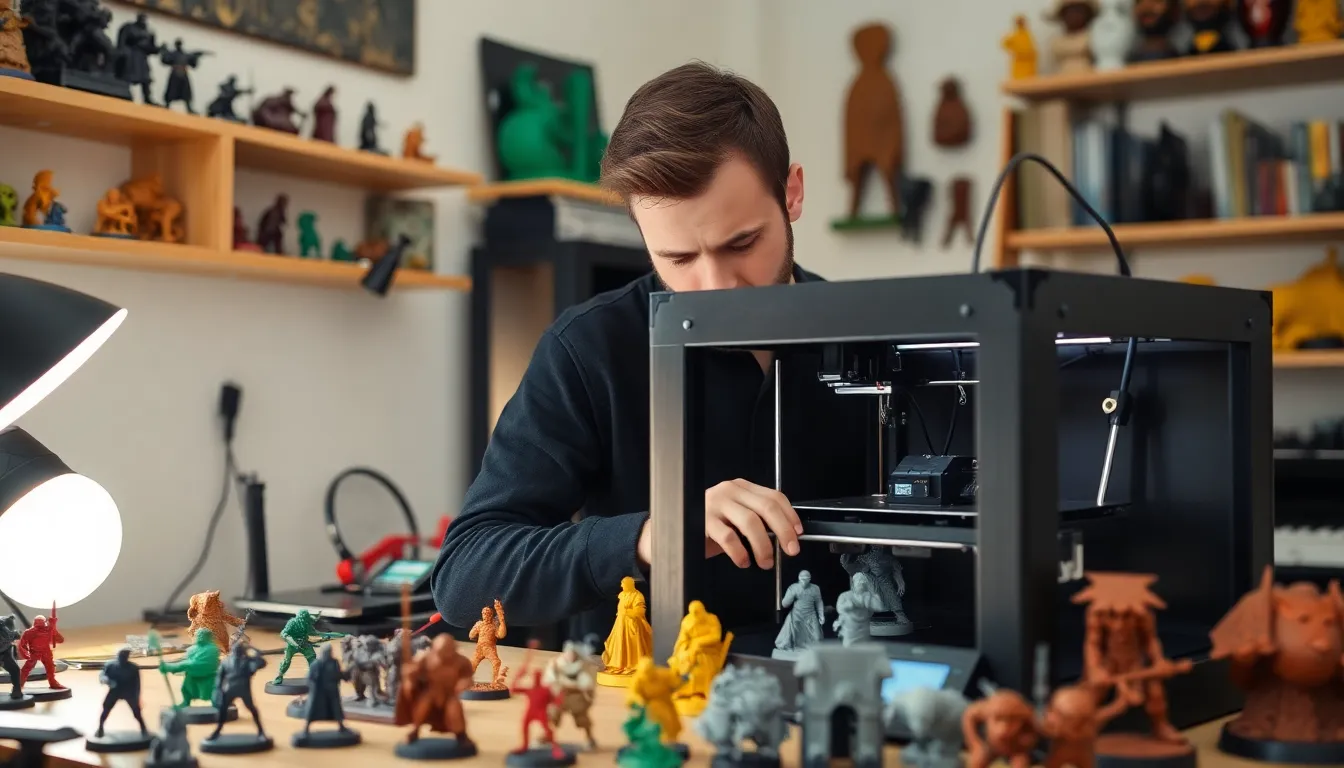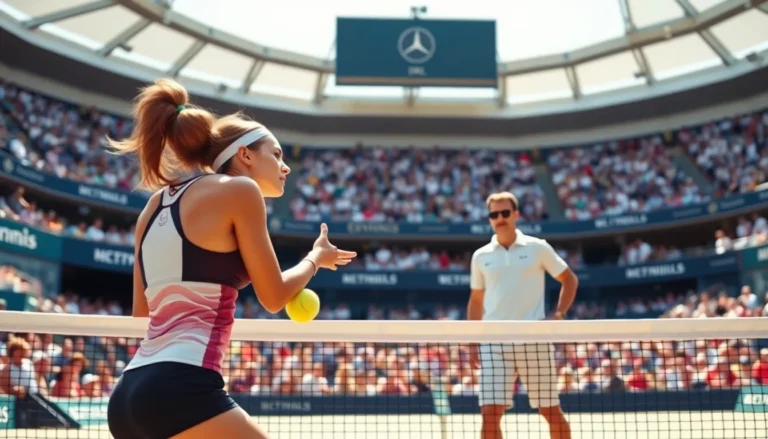In a world where tabletop battles reign supreme, Warhammer 3D printing is the secret weapon every strategist needs. Imagine unleashing a horde of custom miniatures that are as unique as your battle tactics. No more settling for the same old plastic soldiers; it’s time to let creativity run wild and take your gaming experience to the next level.
Table of Contents
ToggleWhat Is Warhammer 3D Printing?
Warhammer 3D printing involves the creation of custom miniatures using additive manufacturing technology. This process allows players to produce unique figures for their tabletop games. Many enthusiasts embrace this method to escape the limitations of traditional plastic figures. Players can design, modify, and print miniatures that reflect their strategic vision and creativity.
3D printing offers various advantages over conventional methods. Cost-effectiveness appears at the forefront, as printing miniatures can save money in the long run. Players often cite the flexibility of designs, which enables them to craft detailed models not available in stores. Many online communities provide a wealth of resources, including downloadable files and tutorials, enhancing the accessibility of crafting customized figures.
Customization stands as another significant benefit of Warhammer 3D printing. Gamers can alter scales, features, and poses, ensuring each piece is tailored to individual preferences. Players capture their styles by integrating personal themes or narratives into their armies. Printing can also facilitate the creation of terrain, scenery, or game accessories, contributing to a more immersive gaming experience.
Many tools and software programs simplify the design process for users. Free and paid software options exist, catering to varying skill levels and project complexity. With numerous online marketplaces, gamers can purchase high-quality STL files for printing. Such resources foster community engagement while ensuring the availability of diverse miniature designs.
Overall, Warhammer 3D printing stands as a revolutionary method for enhancing the tabletop gaming experience. It provides players with unprecedented opportunities for personalization and creativity.
Benefits of Warhammer 3D Printing

Warhammer 3D printing offers numerous advantages that enhance the tabletop gaming experience. Players gain access to unique and personalized miniatures, elevating gameplay and creativity.
Customization Options
Customization options with 3D printing are extensive. Gamers can modify scales, alter features, and change poses of their miniatures. Terrain and accessories can also be designed to match personal themes. Unique designs cater to individual strategies, allowing players to showcase their distinct style. Digital design software enables users of all skill levels to create custom models or adapt existing ones. Printable files from online marketplaces provide a vast library of designs ready for use. Personalized gaming experiences become readily achievable through 3D printing.
Cost-Effectiveness
Cost-effectiveness stands out as a key advantage of 3D printing in Warhammer. Traditional miniatures often come with high price tags; however, creating figures with a 3D printer significantly reduces costs. Filament and resin required for printing remain affordable, allowing repeated creations without heavy investment. Players can produce multiple miniatures for the price of a single store-bought figure. With readily available online resources, generating custom STL files becomes easier. Money saved on purchasing miniatures can instead be allocated to enhance further gaming experiences. Overall, 3D printing presents an economical alternative for building extensive Warhammer collections.
Getting Started with Warhammer 3D Printing
Embarking on the journey of Warhammer 3D printing involves careful considerations in selecting equipment and models. With the right approach, players can maximize their experience.
Choosing the Right Printer
Picking the ideal printer significantly impacts the quality of miniatures. FDM printers offer affordability and accessibility, suitable for beginner users. SLA printers excel in detail and finish, making them perfect for intricate designs. Evaluate printing speed, ease of use, and material compatibility when making a selection. Heavier use demands a printer with a larger build volume and robust capabilities. Researching user reviews or seeking guidance from online communities helps make an informed choice.
Selecting Quality Models
Finding quality models greatly enhances customization options. Numerous online repositories provide a vast array of STL files for download. Trusted websites often feature community ratings that demonstrate model quality. Consider details like scale, pose, and additional features while browsing. Ensuring a good fit for personal themes elevates the gaming experience. Checking forums for recommendations helps find popular file sources and designs. Prioritizing high-resolution models minimizes post-processing work, contributing to overall satisfaction in the final product.
Tips for Successful Warhammer 3D Printing
Successful Warhammer 3D printing requires careful attention to detail and some key considerations. Following the right strategies ensures high-quality miniatures that enhance the gaming experience.
Slicing Software Recommendations
Choosing the right slicing software is crucial for optimal results. Popular options include PrusaSlicer, Cura, and Simplify3D. Each offers unique features tailored to different user needs. PrusaSlicer provides excellent support structures and detailed settings for FDM printers. Cura has a user-friendly interface and extensive community support. Simplify3D supports a wide range of printers and offers advanced control over print parameters. Select a slicer that matches individual printing goals to maximize results.
Post-Processing Techniques
Post-processing significantly enhances the quality of printed miniatures. Techniques such as sanding, trimming, and painting can create a polished look. Sanding removes any imperfections and layer lines, smoothing surfaces for a more professional finish. Trimming excess supports carefully prevents damage to delicate features. Painting adds color and detail, bringing the miniature to life. Using primer before painting helps colors adhere better and achieve vibrant results. Implement these techniques for eye-catching miniatures that stand out on the tabletop.
Common Challenges and Solutions
Many enthusiasts face issues with adhesion during the printing process. Lack of proper surface preparation often leads to miniatures warping or detaching from the build plate. Utilizing adhesive sprays or applying a coating to the build plate can significantly improve adherence.
Print quality often poses another challenge. Over-extrusion and under-extrusion can result in rough surfaces or missing details. Adjusting the printer settings, such as flow rate and temperature, typically remedies this issue, leading to more accurate results.
Support structures frequently create headaches when printing intricate designs. Removing support material can damage delicate features on miniatures. Experimenting with different support settings in slicing software provides effective solutions, allowing for cleaner prints and easy removal.
Color accuracy also represents a common concern. Many find it difficult to achieve the desired shading and finish on their miniatures. Using high-quality paints and priming the surfaces before painting can enhance color vibrancy and improve overall aesthetics.
Time efficiency in printing processes can frustrate those with tight schedules. Long print times often hinder the ability to complete multiple miniatures in a reasonable timeframe. Choosing printers with higher speeds or adjusting layer heights can substantially cut down on printing duration.
Lastly, managing file compatibility presents a challenge for some users. Incompatible file formats can lead to wasted time and materials. Ensuring that downloaded STL files are compatible with slicing software often resolves this issue, allowing for smoother workflows.
Warhammer 3D printing opens up a world of possibilities for tabletop gamers. It allows players to create unique miniatures that reflect their individual strategies and themes. The cost-effectiveness and flexibility of this technology make it an attractive option for building extensive collections without breaking the bank.
With a wealth of resources available online, enthusiasts can easily find STL files and tutorials to enhance their printing skills. Whether it’s selecting the right printer or mastering post-processing techniques, the journey into 3D printing promises creativity and personalization like never before.
As players embrace this innovative approach, the future of Warhammer gaming will undoubtedly be shaped by the limitless potential of custom miniatures.



